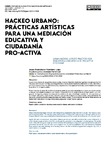Hackeo urbano: prácticas artísticas para una mediación educativa y ciudadanía pro-activa

Use this link to cite
http://hdl.handle.net/2183/27779
Except where otherwise noted, this item's license is described as Atribución-CompartirIgual 4.0 Internacional (CC BY-SA 4.0)
Collections
Metadata
Show full item recordTitle
Hackeo urbano: prácticas artísticas para una mediación educativa y ciudadanía pro-activaAlternative Title(s)
Urban Hacking: Artistic Practices for Educational Mediation and Pro-Active CitizenshipAuthor(s)
Date
2021-03-31Citation
Fuentes-Lojo, J. F. (2021). Hackeo urbano: prácticas artísticas para una mediación educativa y ciudadanía pro-activa. IJABER. International Journal of Arts-Based Educational Research, 1(1), 61-75. https://doi.org/10.17979/ijaber.2021.1.1.7608
Abstract
[Resumen] Los entornos urbanos de las grandes urbes, muchas veces son diseñados desde las organizaciones ajenas a los individuos, su memoria, sus vivencias y sus desigualdades. La trama urbana resultante acaba siendo un tejido discontinuo, por el que nos movemos entre diferentes nodos, empobreciendo los espacios intermedios; es decir, las fricciones que se producen en el espacio público.Frente a este tipo de desarrollo se detectan iniciativas artísticas, que serán estudiadas en el transcurso de este artículo, en las que los ciudadanos adquieren un rol activo en la producción de ciudad a través de la generación o re-configuración de espacios urbanos. Los instrumentos artísticos de esta metodología consisten en micro-acciones con un enfoque participativo; experimental y educativo, que permiten imaginar una nueva ciudad y sus posibilidades. De este modo, podemos entender estas prácticas como hackeo urbano, donde el término hackear se refiere al hecho de transformar e intervenir en el código de la ciudad, para poder cumplir nuevos objetivos. [Abstract] Urban environments in large cities are often designed by organizations disconnected to people, their memory, experiences and inequalities. The resulting urban pattern ends up being a discontinuous layout, through which we move between different nodes, impoverishing the intermediate spaces; in other words, the frictions that occur in public space.Against this kind of development, many artistic initiatives are detected and will be studied in the course of this article, in which citizens acquire an active role in the city through the generation or reconfiguration of urban spaces. The artistic tools of this methodology are made up of micro-actions with a participatory approach; experimental and educational. It seems that they are the ones who allow us to imagine a new city and its possibilities. We would therefore understand these practices as urban hacking, where hacking refers to the fact of transforming and intervening the city code, in order to achieve new goals.
Keywords
Espacio público
Mediación educativa
Transformación urbana
Participación ciudadana
Public space
Educational mediation
Urban transformation
Citizen participation
Mediación educativa
Transformación urbana
Participación ciudadana
Public space
Educational mediation
Urban transformation
Citizen participation
Editor version
Rights
Atribución-CompartirIgual 4.0 Internacional (CC BY-SA 4.0)
ISSN
2697-2018






